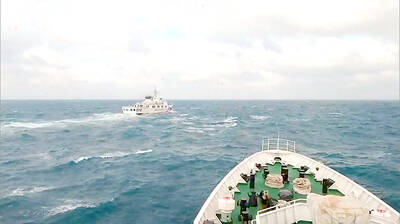Two Chinese military surveillance aircraft were monitored as they flew east of Taiwan yesterday, marking the third time this month that Chinese military planes were detected near the nation, the Ministry of National Defense said.
Two Chinese People’s Liberation Army (PLA) Shaanxi Y-8 aircraft flew northeast through the Bashi Channel to the south, but remained outside of Taiwan’s air defense identification zone (ADIZ), the ministry said.
They later flew over the Miyako Strait, accompanied by two Sukhoi Su-30 fighter jets, before returning to their base in China, it added.
It was the latest in a series of Chinese military activities near Taiwan since last month.
On Wednesday, a Y-8 aircraft was detected flying over the western Pacific Ocean, through the Miyako Strait and into the East China Sea, while on Aug. 5, a group of Chinese Xian H-6K bombers and Y-8 aircraft were seen near Taiwan’s ADIZ.
On July 25, a Xian H-6K bomber flew close to Taiwan’s ADIZ, passing through the Bashi Channel and the Miyako Strait before returning to Chinese airspace, the ministry said.
On July 20, Taiwan scrambled fighter jets as eight H-6K bombers and Y-8 aircraft flew past its east and west coasts, but remained in international airspace.
The Miyako Strait, which lies between the Japanese islands of Miyako and Okinawa, is part of Japan’s exclusive economic zone, but includes a narrow band of international waters and airspace.
The ministry said the maneuvers have been closely monitored.
China has yet to comment on the drills, but its air force has carried out several rounds of long-distance training exercises around Taiwan and southern Japanese islands in recent months.
The frequency at which Chinese military aircraft have been circling the nation is a signal that Beijing intends to make such flights routine, National Taiwan University associate professor of political science Chen Shih-min (陳世民) said yesterday.
It should be expected that Chinese aircraft are to inch closer to the nation’s ADIZ and some might begin gathering intelligence, he said, adding that the PLA judges that Taiwan cannot counter the flights, as military action is considered an outright impossibility.
The flights also serve to show the PLA’s ability to conduct operations within its sovereign claims at will and convince the world that Taiwan is a part of China, he added.
Beijing might believe that the cross-strait political climate gives it no other option to pressure Tsai Ing-wen’s (蔡英文) administration than to show force, he said.
Although Beijing did not find such measures necessary during former president Ma Ying-jeou’s (馬英九) administration, it could be concerned that given time, the nation’s continued independence might become a fait accompli, he said.
Any development in that direction would bode ill for Chinese President Xi Jinping (習近平) at a time when the National Congress of the Chinese Communist Party (CCP) is close at hand, Chen said.
Internal struggles are flaring up ahead of the congress and Xi might have sought to relieve pressures from the hawkish factions through an ostentatious display, Chen said.
The government must register a protest with the international community against any further provocations from Beijing to remind other nations of the situation’s gravity, he said.
Additional reporting by Reuters

Taiwan is gearing up to celebrate the New Year at events across the country, headlined by the annual countdown and Taipei 101 fireworks display at midnight. Many of the events are to be livesteamed online. See below for lineups and links: Taipei Taipei’s New Year’s Party 2026 is to begin at 7pm and run until 1am, with the theme “Sailing to the Future.” South Korean girl group KARA is headlining the concert at Taipei City Hall Plaza, with additional performances by Amber An (安心亞), Nick Chou (周湯豪), hip-hop trio Nine One One (玖壹壹), Bii (畢書盡), girl group Genblue (幻藍小熊) and more. The festivities are to

Auckland rang in 2026 with a downtown fireworks display launched from New Zealand’s tallest structure, Sky Tower, making it the first major city to greet the new year at a celebration dampened by rain, while crowds in Taipei braved the elements to watch Taipei 101’s display. South Pacific countries are the first to bid farewell to 2025. Clocks struck midnight in Auckland, with a population of 1.7 million, 18 hours before the famous ball was to drop in New York’s Times Square. The five-minute display involved 3,500 fireworks launched from the 240m Sky Tower. Smaller community events were canceled across New Zealand’s

The Ministry of Foreign Affairs (MOFA) yesterday said it is closely monitoring developments in Venezuela, and would continue to cooperate with democratic allies and work together for regional and global security, stability, and prosperity. The remarks came after the US on Saturday launched a series of airstrikes in Venezuela and kidnapped Venezuelan President Nicolas Maduro, who was later flown to New York along with his wife. The pair face US charges related to drug trafficking and alleged cooperation with gangs designated as terrorist organizations. Maduro has denied the allegations. The ministry said that it is closely monitoring the political and economic situation

‘SLICING METHOD’: In the event of a blockade, the China Coast Guard would intercept Taiwanese ships while its navy would seek to deter foreign intervention China’s military drills around Taiwan this week signaled potential strategies to cut the nation off from energy supplies and foreign military assistance, a US think tank report said. The Chinese People’s Liberation Army (PLA) conducted what it called “Justice Mission 2025” exercises from Monday to Tuesday in five maritime zones and airspace around Taiwan, calling them a warning to “Taiwanese independence” forces. In a report released on Wednesday, the Institute for the Study of War said the exercises effectively simulated blocking shipping routes to major port cities, including Kaohsiung, Keelung and Hualien. Taiwan would be highly vulnerable under such a blockade, because it